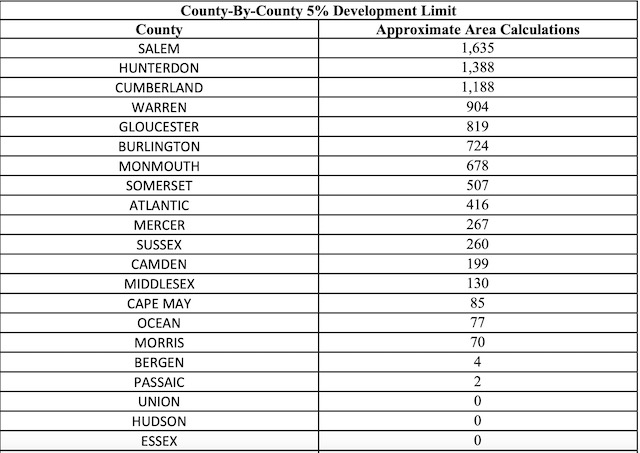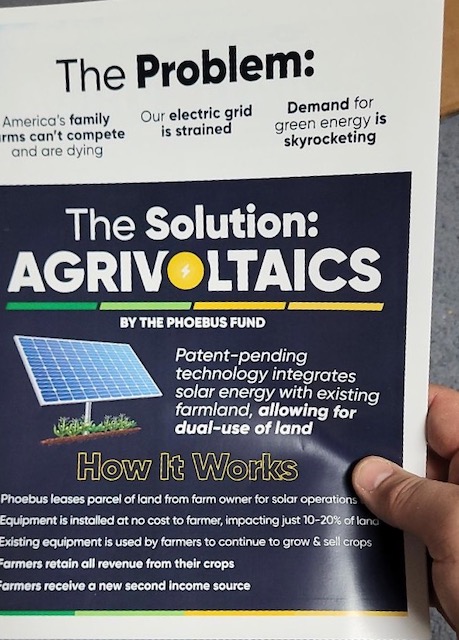Solartopia – or Griftopia?
NJ Local Government “Ratables Chase” Is Becoming A Shakedown Chase
State Legislators Abdicate Land Use And Public Interest Role
Where the hell are the environmental groups?
“Open land in New jersey is like a gold mine,” he said. “There’s money out there that wants to come after the whole state.” (Spotlight)
State Senate President Nicholas Scutari, meanwhile, indicated he had no plans to move the legislation and top Republicans said warehouse decisions were better left to local officials. (Bergen Record)
Between the explosion of warehouses and industrial solar, much of the little that is left of NJ’s rural character is being destroyed – and with little opposition by NJ environmental groups and the support of the Murphy administration and Legislators. [Update: check out the slick corporate marketing pitch, distributed at Warren County Agriculture Board:
NJ’s longstanding land use corruption and abuse – masked by slogans known as the “ratables chase” under “local home rule” – has now become a “shakedown chase”, as illustrated by the recent deal in Harmony Township.
In that case, an industrial solar developer basically flat out bought a local government land use approval of a 70MW industrial solar facility on 600 acres of prime farmland.
But Harmony Township is not unique – similar abuses are happening all across rural NJ – both southern and northwestern.
I) State Legislative and Regulatory Abdication on Warehouse And Solar Development
State lawmakers are abdicating their responsibility to restrict these land use and financial abuses.
For example, I reached out to Senate Environment Committee Chairman Bob Smith and requested he review and respond to the industrial solar abuse in Harmony Township:
I urge you to revisit the land use issues in light of this decision and consider legislation to address the issues of “host community benefits”.
It is an invitation to corruption to continue the current practice of allowing municipalities to negotiate these huge economic, energy, and land use issues in the absence of State policies and standards and a transparent and participatory public process.
I was not optimistic about the prospects of legislative reforms:
Given Smith’s strong support of industrial scale solar, his recent flawed legislation which actually promotes solar on farmland, and his dead-set opposition to more land use controls, there is zero chance of success.
So, I was quite surprised to receive a reply from Senator Smith yesterday. Smith forwarded the Office of Legislative Services (OLS) non-partisan professional staff’s response to my concerns.
I won’t share that correspondence, but simply note that both Smith and OLS completely missed both the land use and ethics issues (as I predicted).
But Harmony Township is not a unique case – there are several large scale industrial solar development and warehouses that have either recently received local and DEP approvals or are undergoing review right now.
Approvals of NJ warehouse developments are being quietly rubber stamped by the Murphy DEP – who have gotten a pass by environmental groups and media – while State legislators have not only failed to respond, but supported the explosion of warehouse developments.
Recent amendments of NJ solar incentive laws also are pouring gasoline on the fire.
I’m not aware of any environmental groups or State agencies that are monitoring the statewide situation or considering the cumulative impacts of warehouse, solar and even new residential development (State Planning Commission and Rutgers land use data generally lags years behind the land loss).
II) Fake Solar Siting Restrictions
Under NJ’s recent solar incentive law revisions (P.L 2021, c. 169), in a move to create the appearance of State land use policy, the legislature established some restrictions on where solar facilities could be developed (e.g. not in the preservation area of the Pinelands or Highlands, forests, wetlands, prime agricultural soils, or on preserved lands).
(under prior law, solar can even be sited on preserved farmlands).
The solar siting law did not amend the Municipal Land Use Law or NJ’s other land use, climate, or environmental laws.
Instead, it structured what should be a land use planning, climate, and environmental program in the domain of energy promotion law and put the BPU – not the DEP – in charge.
As a result, the reality is a market driven and economically based (“cost effective“) siting program whose primary objective is to promote solar – not reduce greenhouse gas emissions (ostensibly the goal of solar), protect natural resources or plan for or regulate land use.
BPU recently released a “straw proposal” to implement the law. The public comment period on that closed on April 22 (I didn’t see any press reports on that proposal or warnings or ACTION ALERTS by environmental groups).
With the exception of preserved lands, the alleged siting restrictions are lax and really meaningless because the law provides for a waiver: (BPU straw proposal)
Section 6(c) of the Act lists a series of land uses that are not authorized for solar project siting unless the applicant, in accordance with Section 6(f) of the Act, files a waiver petition with, and receives approval from, the Board to proceed.
The implications of the waiver can be seen most obviously in the BPU staff recommendation that solar be prohibited from siting on forested lands. After explaining what it would be counter-productive to site a solar facility on forested lands, BPU blows a huge loophole in the “prohibition:
In general, Staff recommends that the Board establish rules that prohibit the siting of solar facilities on forested lands. Forested land acts as a carbon dioxide sink that helps to sequester CO2 emissions. Destruction of high- quality forested areas for the sole purpose of installing solar projects undermines many of the principal goals encouraging the construction of additional solar facilities, and goes contrary to the desire to ensure that carbon dioxide already sequestered in forests continues to remain sequestered. […]
Staff proposes that solar projects seeking to be located on forested lands as defined above would be required to file a petition for waiver, pursuant to Section 6(f) of the Solar Act,
BPU staff do not recommend any public notice and comment or other form of public participation in waiver reviews and approvals.
There are no substantive standards in the waiver provision to limit the vague phrase “the public interest“.
Worse, BPU staff are openly recommending corrupt “mitigation” deals:
Staff proposes that the Board and its sister agencies consider any mitigation measures project proponents suggested in determining whether a particular solar project is in the public interest, such as proposals that include preservation of other lands (e.g., donating substantial desirable land into permanent conservation), and or the like.
Siting solar on agricultural (farmland) is even worse than forested lands.
In addition to the waiver, there is a flat out exemption of 2.5% of agricultural land:
Staff interprets the Act as allowing solar development on the first 2.5% of Prime Agricultural Soils/Soils of Statewide Importance that are in ADAs statewide (“2.5% Statewide Threshold”), subject to the limitations found in Section 6(f) that limit total development within a given county. This first 2.5% would therefore be exempt from the general prohibition on siting on Prime Agricultural Soils/Soils of Statewide Importance contained in Section 6(c). Any development on these farmlands above the 2.5% Statewide Threshold would only be allowed if the solar developer seeks and receives a waiver under Section 6(f), as discussed below.
Some might think that 2.5% is a small amount of farmland that would be lost to industrial solar – but it represents 8,500 acres! That’ over 13 square miles. (see page 20)
And the remaining 97.5% (331,000) can be developed under the site specific waiver!
Thus, effectively, the siting of solar facilities is delegated to local governments and local land use zoning and the profit seeking of private corporate developers. BPU explicitly states that site selection is made by solar developers, base primarily on economic considerations (and local land use zoning): (BPU straw proposal):
to keep project costs reasonable, developers generally need to evaluate a number of potential parcels, and select the most cost effective location. Thus, the universe of land potentially available for development is expected to be greater than the number of acres that will actually be used for solar development.
As I recently concluded, all this is:
That is a formula for rapid destruction of what’s left of NJ’s forests and farms and rural character. Period.
[Update: A knowledgeable reader takes me to task (to which I reply I specifically mentioned “residential development” by that was not the focus of this post):
You missing the biggest sprawl issue out there – its the courts , Fairshair (SIC) and the builders – it is system run amok – christie got rid of Coah – the courts stepped in with builders and fairshare – and pro development mayors – all the bad projects we stopped over the years are back – Westside of Scotch Rd-Pointview Reservoir Wayne ,Pigeon Swamp in East Brunswick – Golf course in Hillsborough – plus dozens of others – plus toxic sites GM Hyatt bearing site Westfield – GM in Ewing – Chromium sites in JC – plus massive up zoning –

